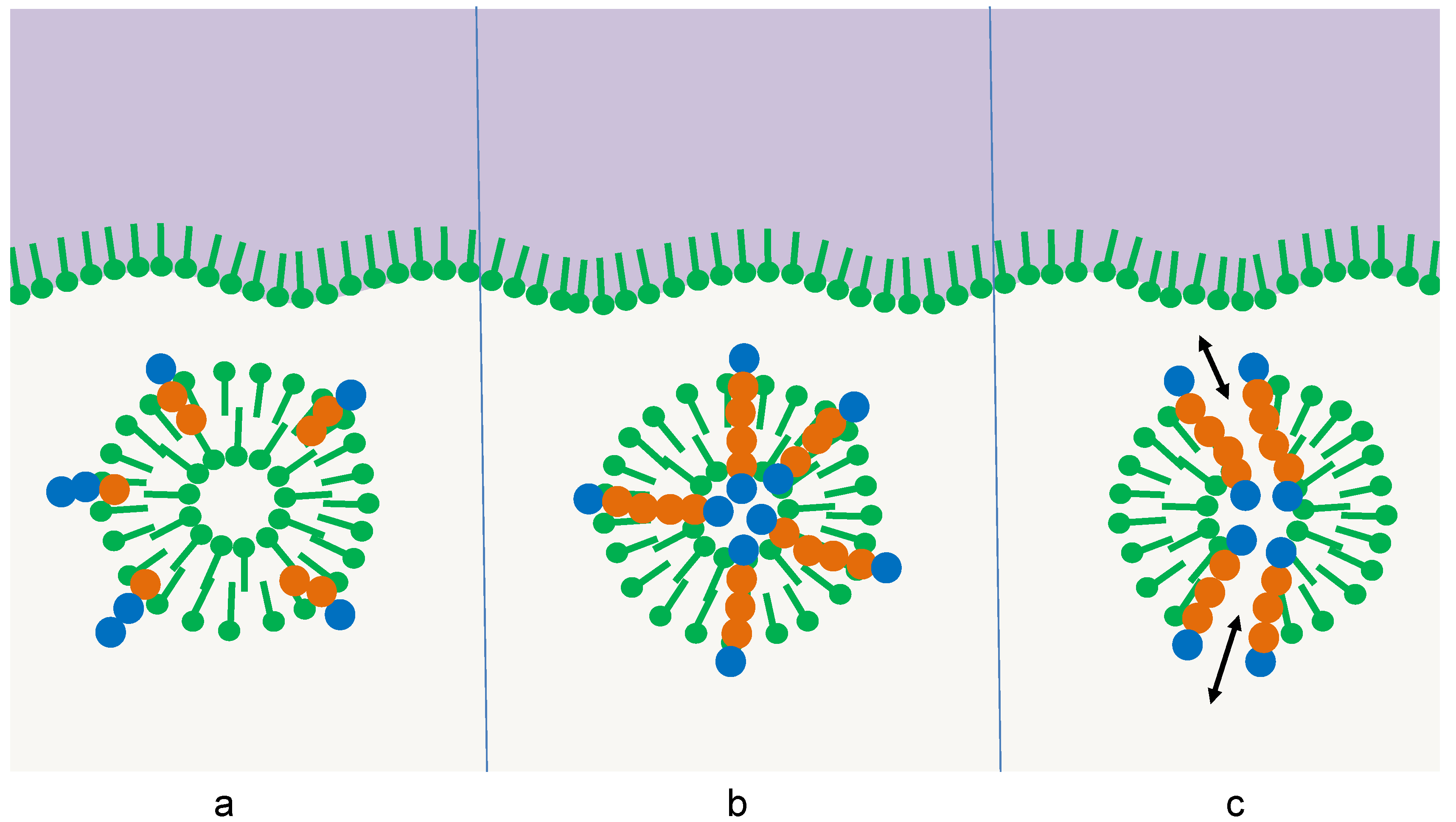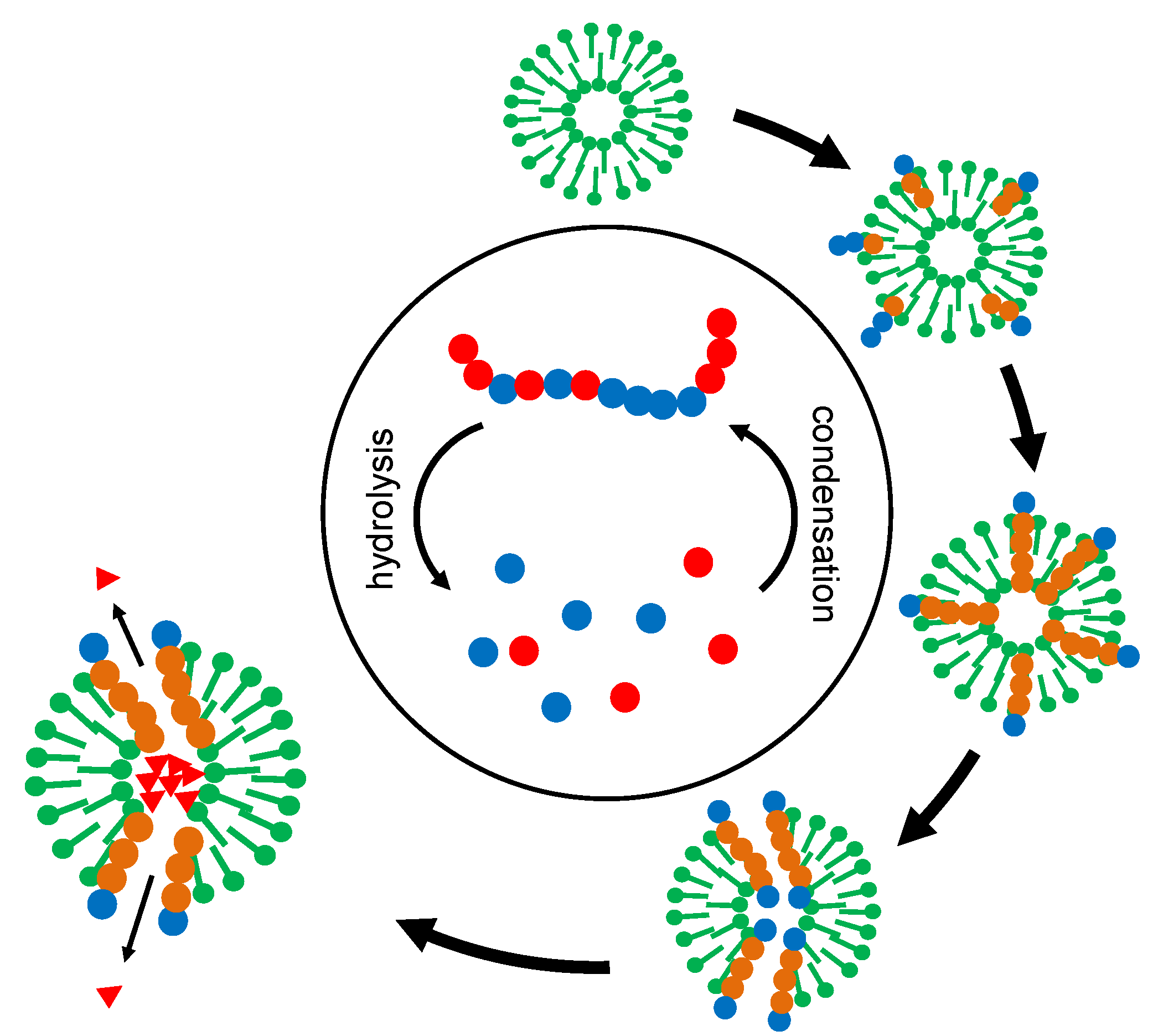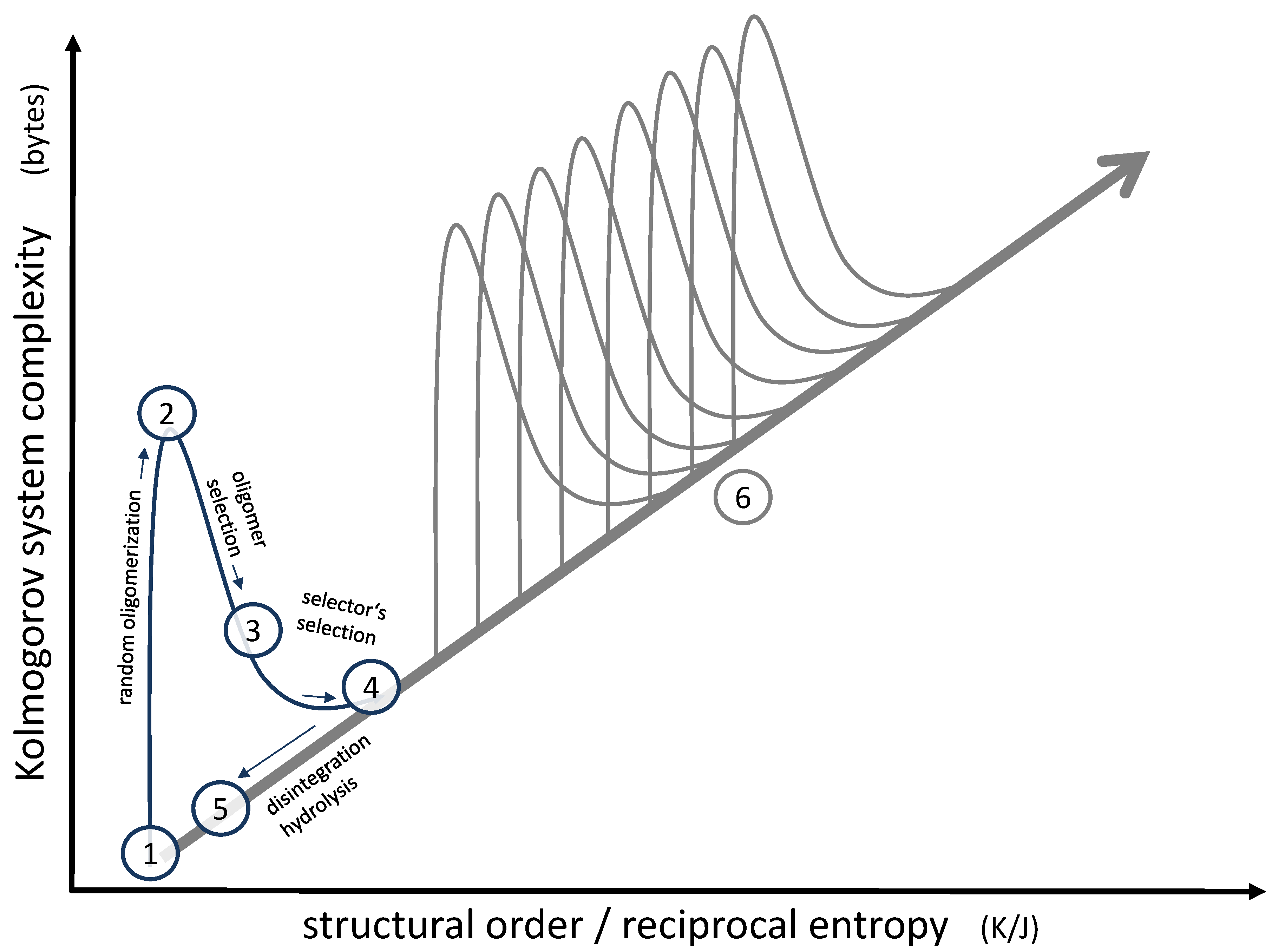Spontaneous Formation of Functional Structures in Messy Environments
Abstract
:1. The Creative Potential of Messy Prebiotic Chemistry
| condensation reactions (with rate constant kc) | hydrolysis reactions (with rate constant kh) |
| A1 + A1 -> A2 x2 (1) | A2 -> A1 + A1 |
| A1 + A2 -> A3 x2 (1) | A3 -> A1 + A2 x2 (2) |
| A1 + A3 -> A4 x2 (1) | A4 -> A1 + A3 x2 (2) |
| A1 + A4 -> A5 x2 (1) | A4 -> A2 + A2 |
| A1 + A5 -> A6 x2 (1) | A5 -> A1 + A4 x2 (2) |
| A2 + A2 -> A4 x2 (1) | A5 -> A2 + A3 x2 (2) |
| A2 + A3 -> A5 x2 (1) | A6 -> A1 + A5 x2 (2) |
| A2 + A4 -> A6 x2 (1) | A6 -> A2 + A4 x2 (2) |
| A3 + A3 -> A6 x2 (1) | A6 -> A3 + A3 |
- (1)
- These reactions have to be considered with a factor of two since each amino acid (or peptide) on the left side of the equation offers two possible reaction sites, -COOH and –NH2.
- (2)
- These reactions have to be considered with a factor of two since the hydrolysis can occur at two different positions, each leading to an equivalent pair of products.
2. The Potential Nature of a “Selector”
3. The Selection of the Selector
- (a)
- Oligomers with sequences of type (a) have a destabilizing effect on the membrane multilayer, the micelle, or the vesicle. In this case, the amphiphilic structure would come apart sooner than the competing ones, the amphiphiles would assemble at other surfaces, and the oligomers would be released. In the following, they are subject to hydrolysis just like the other oligomers in the pool and gain only a small temporary advantage.
- (b)
- Oligomers with sequences of type (b) stabilize the membrane multilayer, the micelle, or the vesicle. The increase in thermal stability could derive from particular interactions between the oligomer and the adjacent amphiphiles. In this case, the lifetime of the structure would be extended, leading to extended protection of the oligomers with sequences of type (b) due to the reduced access of water molecules [26]. Hence, the sequences (b) would accumulate much more efficiently than the sequences (a).
- (c)
- Oligomers with sequences of type (c) induce a more complex stabilizing function on the membrane multilayer, the micelle, or the vesicle. This effect goes beyond a simple thermodynamic stabilization by selective interactions. Instead, it compensates for destructive influences that shorten the lifetime of the amphiphilic structure. An example may be osmotic pressure, which regularly occurs during membrane formation. If an oligomer with a sequence (c) is capable of forming a transmembrane pore [26], this osmotic pressure can be released, leading to extended membrane longevity. Other specific functions may be the induction of a specific membrane curvature, the induction of a specific membrane mobility, or the accumulation of charges on the membrane surface. All these functions induced by sequences (c) could further extend the lifetime of the selector and hence give them an additional selective advantage.
- (i)
- Thermal stabilization of the vesicle membrane;
- (ii)
- An increase in the permeability of the vesicle membrane;
- (iii)
- A decrease in the vesicle size.
4. Spontaneous Formation of Order and Complexity
5. Conclusions
Funding
Institutional Review Board Statement
Informed Consent Statement
Data Availability Statement
Conflicts of Interest
References
- Dyson, F.J. Origins of Life; Cambridge University Press: Cambridge, UK, 1999. [Google Scholar]
- Deamer, D. Assembling Life; Oxford University Press: Oxford, UK, 2019. [Google Scholar]
- Dobson, C.M. Chemical space and biology. Nature 2004, 432, 824–828. [Google Scholar] [CrossRef] [PubMed]
- Reymond, J.-L. The chemical space project. Acc. Chem. Res. 2015, 48, 722–730. [Google Scholar] [CrossRef] [PubMed] [Green Version]
- Matsuno, K. Polymer. In Encyclopedia of Astrobiology; Springer: Berlin, Germany, 2011; pp. 788–790. [Google Scholar]
- Chandru, K.; Jia, T.Z.; Mamajanov, I.; Bapat, N.; Cleaves, H.J. Prebiotic oligomerization and self-assembly of structurally diverse xenobiological monomers. Sci. Rep. 2020, 10, 17560. [Google Scholar] [CrossRef] [PubMed]
- Jia, T.Z.; Chandru, K.; Hongo, Y.; Afrin, R.; Usui, T.; Myojo, K.; Cleaves, H.J. Membraneless polyester microdroplets as primordial compartments at the origins of life. Proc. Natl. Acad. Sci. USA 2019, 116, 15830–15835. [Google Scholar] [CrossRef] [PubMed] [Green Version]
- Chandru, K.; Mamajanov, I.; Cleaves, H.J.; Jia, T.Z. Polyesters as a model system for building primitive biologies from non-biological prebiotic chemistry. Life 2020, 10, 6. [Google Scholar] [CrossRef] [Green Version]
- Mayer, C.; Schreiber, U.; Dávila, M.J. Selection of prebiotic molecules in amphiphilic environments. Life 2017, 7, 3. [Google Scholar] [CrossRef] [Green Version]
- Waasmann, L.E.; Dávila, M.J.; Mayer, C.; University of Duisburg-Essen, Duisburg, Germany. 2018; Unpublished results.
- Borel, E. Mécanique statistique et irréversibilité. 5e série. J. Phys. 1913, 3, 189–196. [Google Scholar]
- Fox, S.; Strasdeit, H. Chemical evolution on primordial volcanic islands. EPSC Abstr. 2010, 5, 358. [Google Scholar]
- Damer, B.; Deamer, D. The hot springs hypothesis of life. Astrobiology 2020, 20, 429–452. [Google Scholar] [CrossRef] [Green Version]
- Damer, B.; Deamer, D. Coupled phases and combinatorial selection in fluctuating hydrothermal pools: A scenario to guide experimental approaches to the origin of cellular life. Life 2015, 5, 872–887. [Google Scholar] [CrossRef] [Green Version]
- Schreiber, U.; Locker-Grütjen, O.; Mayer, C. Hypothesis: Origin of life in deep-reaching tectonic faults. Orig. Life Evol. Biosph. 2012, 42, 47–54. [Google Scholar] [CrossRef] [PubMed]
- Mayer, C.; Schreiber, U.; Dávila, M.J. Periodic vesicle formation in tectonic fault zones—An ideal scenario for molecular evolution. Orig. Life Evol. Biosph. 2015, 45, 139–148. [Google Scholar] [CrossRef] [PubMed] [Green Version]
- Schreiber, U.; Mayer, C.; Schmitz, O.J.; Rosendahl, P.; Bronja, A.; Greule, M.; Keppler, F.; Mulder, I.; Sattler, T.; Schöler, H.F. Organic compounds in fluid inclusions of Archean quartz—Analogues of prebiotic chemistry on early Earth. PLoS ONE 2017, 12, e0177570. [Google Scholar] [CrossRef] [PubMed] [Green Version]
- Black, R.A.; Blosser, M.C.; Stottrup, B.L.; Tavakley, R.; Deamer, D.W.; Keller, S.L. Nucleobases bind to and stabilize aggregates of a prebiotic amphiphile, providing a viable mechanism for the emergence of protocells. Proc. Natl. Acad. Sci. USA 2013, 110, 13272–13276. [Google Scholar] [CrossRef] [Green Version]
- Le Chevalier Isaad, A.; Carrara, P.; Stano, P.; Krishnakumar, K.S.; Lafont, D.; Zamboulis, A.; Buchet, R.; Bouchu, D.; Albrieux, F.; Strazewski, P. A hydrophobic disordered peptide spontaneously anchors a covalently bound RNA hairpin to giant lipidic vesicles. Org. Biomol. Chem. 2014, 12, 6363–6373. [Google Scholar] [CrossRef]
- Strazewski, P. Omne vivum ex vivo … omne? How to feed an inanimate evolvable chemical system so as to let it self-evolve into increased complexity and life-like behavior. Isr. J. Chem. 2015, 55, 851–864. [Google Scholar] [CrossRef]
- Black, R.A.; Blosser, M.C. A self-assembled aggregate composed of a fatty acid membrane and the building blocks of biological polymers provides a first step in the emergence of protocells. Life 2016, 6, 33. [Google Scholar] [CrossRef] [Green Version]
- Xue, M.J.; Black, R.A.; Cornell, C.E.; Drobny, G.P.; Keller, S.L. A step toward molecular evolution of RNA: Ribose binds to prebiotic fatty acid membranes, and nucleosides bind better than individual bases do. ChemBioChem 2020, 21, 2764–2767. [Google Scholar] [CrossRef]
- Cohen, Z.R.; Nguyen, J.; Hazra, A.; Lalic, G.; Black, R.A.; Keller, S.L. Fatty acid membranes boost peptide yield and implications for the origins of cellular life. Biophys. J. 2020, 118, 228A. [Google Scholar] [CrossRef]
- Xue, M.J.; Black, R.A.; Cohen, Z.R.; Roehrich, A.; Drobny, G.P.; Keller, S.L. Binding of dipeptides to fatty acid membranes explains their colocalization in protocells but does not select for them relative to unjoined amino acids. J. Phys. Chem. B 2021, 125, 7933–7939. [Google Scholar] [CrossRef]
- Cohen, Z.R.; Cornell, C.E.; Catling, D.C.; Black, R.A.; Keller, S.L. Prebiotic protocell membranes retain encapsulated contents during flocculation, and phospholipids preserve encapsulation during dehydration. Langmuir 2022, 38, 1304–1310. [Google Scholar] [CrossRef] [PubMed]
- Mayer, C.; Schreiber, U.; Dávila, M.J.; Schmitz, O.J.; Bronja, A.; Meyer, M.; Klein, J.; Meckelmann, S.W. Molecular evolution in a peptide vesicle system. Life 2018, 8, 16. [Google Scholar] [CrossRef] [PubMed] [Green Version]
- Deamer, D. The role of lipid membranes in life’s origin. Life 2017, 7, 5. [Google Scholar] [CrossRef] [PubMed]
- Sakuma, Y.; Imai, M. From vesicles to protocells: The roles of amphiphilic molecules. Life 2015, 5, 651–675. [Google Scholar] [CrossRef]
- Simoneit, B.R.T. Prebiotic organic synthesis under hydrothermal conditions: An overview. Adv. Space Res. 2004, 33, 88–94. [Google Scholar] [CrossRef]
- Aponte, J.C.; Whitaker, D.; Powner, M.W.; Elsila, J.E.; Dworkin, J.P. Analyses of aliphatic aldehydes and ketones in carbonaceous chondrites. ACS Earth Space Chem. 2019, 3, 463–472. [Google Scholar] [CrossRef]
- Großmann, Y.; Schreiber, U.; Mayer, C.; Schmitz, O.J. Origin of life: Aliphatic aldehydes in the Earth’s crust—Remains of prebiotic chemistry? Res. Sq. 2022. [Google Scholar] [CrossRef]
- Segré, D.; Ben-Eli, D.; Deamer, D.W.; Lancet, D. The lipid world. Orig. Life Evol. Biosph. 2001, 31, 119–145. [Google Scholar] [CrossRef]
- Kahana, A.; Maslov, S.; Lancet, D. Dynamic lipid aptamers: Non-polymeric chemical path to early life. Chem. Soc. Rev. 2021, 50, 11741–11746. [Google Scholar] [CrossRef]
- Dávila, M.J.; Mayer, C. Membrane structure obtained in an experimental evolution process. Life 2022, 12, 145. [Google Scholar] [CrossRef]
- Kondepudi, D.; Prigogine, I. Modern Thermodynamics: From Heat Engines to Dissipative Structures, 2nd ed.; John Wiley & Sons: New York, NY, USA, 2015. [Google Scholar]
- Mayer, C. Life in the context of order and complexity. Life 2020, 10, 5. [Google Scholar] [CrossRef] [PubMed] [Green Version]
- Li, M.; Vitányi, P. Preliminaries. In An Introduction to Kolmogorov Complexity and Its Applications; Texts in Computer Science; Springer: New York, NY, USA, 2008. [Google Scholar]
- Chessari, S.; Thomas, R.; Polticelli, F.; Luisi, P.L. The prosuction of de novo folded proteins by a stepwise chain elongation: A model for prebiotic chemical evolution of macromolecular sequences. Chem. Biodivers. 2006, 3, 1202–1210. [Google Scholar] [CrossRef] [PubMed]
- Wieczorek, R.; Adamala, K.; Gasperi, T.; Polticelli, F.; Stano, P. Small and random peptides: An unexplored reservoir of potentially functional primitive organocatalysts. The case of seryl-histidine. Life 2017, 7, 19. [Google Scholar] [CrossRef] [PubMed] [Green Version]






Publisher’s Note: MDPI stays neutral with regard to jurisdictional claims in published maps and institutional affiliations. |
© 2022 by the author. Licensee MDPI, Basel, Switzerland. This article is an open access article distributed under the terms and conditions of the Creative Commons Attribution (CC BY) license (https://creativecommons.org/licenses/by/4.0/).
Share and Cite
Mayer, C. Spontaneous Formation of Functional Structures in Messy Environments. Life 2022, 12, 720. https://doi.org/10.3390/life12050720
Mayer C. Spontaneous Formation of Functional Structures in Messy Environments. Life. 2022; 12(5):720. https://doi.org/10.3390/life12050720
Chicago/Turabian StyleMayer, Christian. 2022. "Spontaneous Formation of Functional Structures in Messy Environments" Life 12, no. 5: 720. https://doi.org/10.3390/life12050720
APA StyleMayer, C. (2022). Spontaneous Formation of Functional Structures in Messy Environments. Life, 12(5), 720. https://doi.org/10.3390/life12050720






